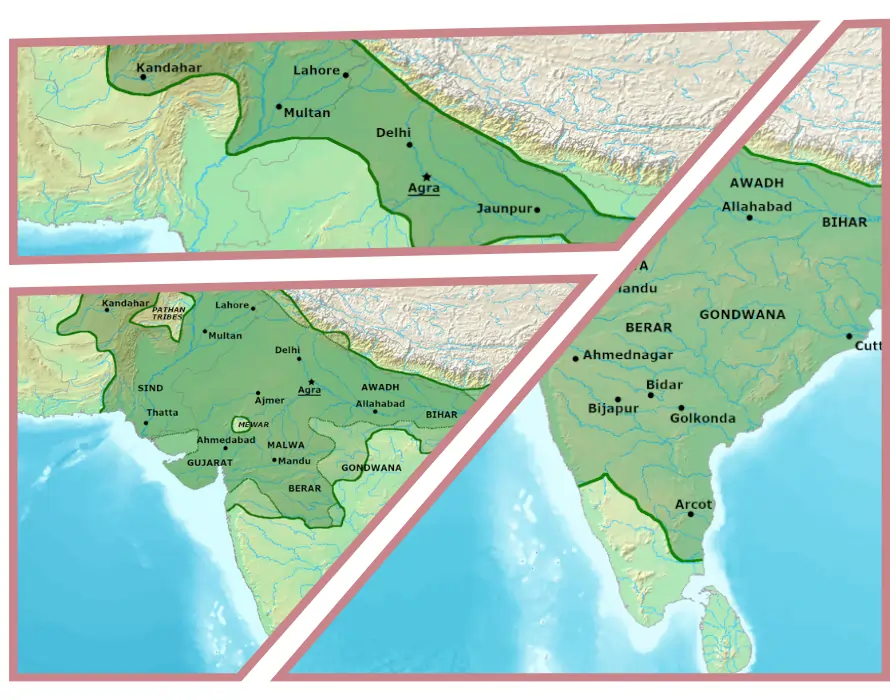The Mughal Empire, one of the most powerful dynasties in Indian history, spanned centuries of remarkable conquests and cultural advancements. The empire’s territorial extent, administrative innovations, and legacy evolved under each ruler.
This article explores the territorial maps and expansion strategies of Babur, Akbar, and Aurangzeb, highlighting how the empire transformed from a fledgling kingdom to the largest empire in Indian history.
The Mughal Empire Under Babur: The Foundation
Babur (1526–1530), the founder of the Mughal Empire, established his rule in northern India after a decisive victory at the First Battle of Panipat in 1526. His conquests laid the groundwork for what would become a vast empire under his successors.
Territorial Map of Babur’s Empire

Image Source: Wikipedia
Key Regions Covered:
- Northern India, including Punjab, Delhi, and Haryana.
- Key cities like Agra, which became a Mughal stronghold.
- Regions of present-day Afghanistan, including Kabul and Kandahar.
Notable Campaigns:
Babur’s victories over Ibrahim Lodi and later against the Rajputs were pivotal in securing the heartland of northern India.
Characteristics of Babur’s Reign
- His empire was relatively small but strategically significant.
- Babur introduced gunpowder warfare to the Indian subcontinent, marking a turning point in military tactics.
Akbar’s Mughal Empire: A Period of Expansion and Consolidation
Akbar (1556–1605), Babur’s grandson, is often credited with turning the Mughal Empire into a vast, stable, and prosperous kingdom. Through diplomacy and military strength, he vastly expanded the empire’s borders.
Territorial Map of Akbar’s Empire

Image Source: Wikipedia
Key Regions Covered:
- Northern India, extending from Kabul in the northwest to Bengal in the east.
- Central India, including modern-day Madhya Pradesh and Gujarat.
- Parts of the Deccan Plateau.
- Rajasthan, after successfully subduing Rajput rulers.
Major Conquests:
Campaigns in Gujarat, Bengal, and central India were milestones in Akbar’s reign. Strategic alliances, including matrimonial alliances with Rajput rulers, strengthened the empire.
Key Features of Akbar’s Reign
- Administrative Reforms:
Akbar introduced the Mansabdari system, which organized the military and bureaucracy efficiently. - Religious Tolerance:
Akbar promoted a policy of tolerance, fostering unity among his diverse subjects. - Economic Growth:
Trade flourished, making the Mughal Empire a significant economic power.
Aurangzeb’s Mughal Empire: The Zenith and Challenges
Aurangzeb (1658–1707) expanded the Mughal Empire to its greatest territorial extent, covering nearly the entire Indian subcontinent. However, his reign was also marked by administrative challenges and internal dissent.
Territorial Map of Aurangzeb’s Empire

Image Source: Wikipedia
Key Regions Covered:
- From modern-day Pakistan and Afghanistan in the northwest to Bengal in the east.
- Central India and the Deccan Plateau, including Bijapur and Golconda.
- Southern India, encompassing Tamil Nadu and parts of Karnataka.
Major Campaigns:
- Aurangzeb’s prolonged campaigns in the Deccan brought significant territories under Mughal control but drained resources.
Characteristics of Aurangzeb’s Reign
- Religious Policies:
Aurangzeb’s strict religious policies created dissent among sections of the population. - Administrative Strain:
The empire’s vast size made governance challenging, leading to rebellions and administrative inefficiencies. - Economic and Military Strain:
Constant wars, especially in the Deccan, weakened the empire’s stability.
Comparing the Maps: Babur, Akbar, and Aurangzeb
Here’s how the territorial extent of the Mughal Empire evolved under these rulers:
| Ruler | Territorial Reach | Key Characteristics |
|---|---|---|
| Babur | Northern India, Kabul, and parts of Afghanistan. | A small, strategic empire established through warfare. |
| Akbar | Northern and central India, parts of the Deccan Plateau, and Bengal. | An expansive empire with strong administration. |
| Aurangzeb | Almost the entire Indian subcontinent, including southern India. | Largest territorial reach but faced significant challenges. |
Conclusion
The Mughal Empire under Babur, Akbar, and Aurangzeb showcases an incredible journey of territorial expansion and administrative evolution. From Babur’s modest beginnings to Aurangzeb’s vast dominion, each ruler contributed to the empire’s legacy. However, challenges of governance and policy ultimately shaped their reigns differently. Studying their maps helps us understand the complexity and grandeur of the Mughal dynasty.


